QuestionQUESTION: I am desprate!! I purchase a 5-6 month old bearded dragon 10 days ago. I had her shipped to me. When she arrived she was cold. We put her in her room (30 long glass tank) to warm her up. For the first couple days we didn't have her room warm enough but we are there now. In her basking area it is between 103-108, her cool area is 85-87. Her night time temp. never gets below 65. If it does I turn on my ceramic heater. It is on the outside of the tank. I also have a 65 watt GE reveal flood lamp, on the inside about 12 in. from her basking area. I also have a ESU reptile slimline desert 7% uvb lamp on the inside.
In the 10 days we have had her she has only eaten 4 superworms, 2 butters,and a small handfull of dark greens(one day) I have tried crickets and phoenix worm but nothing. We have tried to hand feed her, use a bowl and even just dropping them in with very little luck. I have been able to get her to drink from an eye dropper about 10 drops and then she turns her head and closes her eyes. I have given her 2 baths, but how long do you soak them?? She has had 2 bowl movements, the first on day 3 soft like bird poop, the second on day 6, it was much harder and formed. She does move around her room but not much. She mostly crawls into the corner and digs a little and then just lays there, some times with her back legs straight out. Some times her eyes are open. I had to remove her hide, because all she would do is dig under it and stay there all day. She would get cold.
I have contacted the breeder, but he hasn't been much help other then to tell me a glass tank isn't suitable for her room. He did help with the heat issue. But I am at a loss, we are desperate to get her to eat. I hope I have given you enough info.
Thanks
Renee
ANSWER: Hi Renee,
I'm sorry to hear your breeder isn't helping you as he should.
I'm including a care sheet that I wrote to help people out with care.
It also includes links to good information sites, links for finding vets in your area and a very important link on proper uvb.
Its normal for them to take time to settle in. It sounds like she may have a low level of gut bacteria,(loose stools) due to being cold and also stress. You can use products such as Nutri Bac, Bene Bac, Acidolophliz+ to boost her gut bacteria levels up.The bene Bac is labeled for birds, but approved for reptiles and is generally available in the larger pet stores. The other two are available on line. I also use human grade acidophilus which is available at Wal Mat, CVS, etc. With the capsules, one capsule would give her at least 3 days worth of treatment, which is recommended. She may also have a heavy load of internal parasites due to stress..which is common. All reptiles have parasites, which they need..but when stressed the load can become greater than they need. Having a fecal done to check the level is suggested. The "gut boosters" I mentioned above will help get the gut working again, especially needed after any medications.
The uvb you are using is not a recommended one based on the new studies. See the link in the care sheet. Do you have the uvb and the heat in the same area? Its needed to be set up that way. Many beardie owners like using the Mega Ray bulbs since they are a bulb that provides uvb and heat in one.
Her night time temps may be dropping too low.. also, depending on the type of thermometer you are using and also where it is placed may be giving false readings..or not the actual reading in the area. This can be causing her to want to hide..if the basking area is too hot. You want a gradient (slowly rising) basking temperature of 95-105 degrees. She also needs a daytime cool area of normal room temperature of low to mid 70's in addition to the ambient temperature range in the mid 80's and basking temps.. It's tough to get all the ranges they need in a tank smaller than a 50 gallon.The ambient temperature . Cool daytime range of Is the room she is in a busy room? Other pets, people always moving about? If yes, you may want to try covering a side of the tank to lessen the activity she sees for a few days and slowly remove the towel to expose her to more of the sights there.
You can try offering her some baby food chicken also. Its a good thing to mix in one of the gut boosters with.
If after the gut booster, she doesn't start eating, then a vet visit is needed and a fecal should be done regardless.
BASIC BEARDED DRAGON CARE:
HOUSING:
For an adult bearded Dragon, a 50 -55 gallon is the smallest recommended tank. For a baby, nothing less than a 30 gallon tank will work for a very short time, so its best to just start out with the adult sized tank....you can add rocks and branches for climbing, being sure to not stack rocks too high to prevent them toppling over. Branches need to be secure. They like to have a hide log or cave too!! All items brought from outside need to be cleaned well before placing them in the BD's tank. To clean them, there are a few methods: to wash in a bleach solution of 1/4 cup of bleach to 1 gallon of water. Let them soak for about an hour, rinse them in hot water several times and then let them dry in the sun until completely dry. If the items are small enough, they can be baked in an over at 200 degrees for about 2 hours, check often to be sure they are not starting to burn. The items can also be boiled(simmered) for 30 minutes or so and then allowed to dry completely before
placing in the tank. I also suggest washing any pet store items such as caves, rocks, branches, etc before placing in the tank as that if the store would happen to have mites they can also be on the items we purchase. Any of the above methods are acceptable for cleaning. CAUTION!!! On store bought branches...be VERY careful with the driftwood pieces that have the holes in them!!! Be sure the holes are small as that if the holes are large, the BD MAY be able to get his head in them but not able to get it back out!!! A secure screen top is necessary for bearded dragons as that also they do not require much height for climbing..they can and do climb!! NEVER USE HEAT ROCKS OR HEATED CAVES!!! They malfunction and cause severe burns and even death!!!!
SUBSTRATES:
Young bearded dragons MUST be kept on paper towels, newspaper or other non particulate(loose) substrate to prevent them from getting any loose substrate into their mouth and swallowing it which can and does cause intestinal blockages.Once the BD is over 10 inches, some people have had good luck using play sand mixed with 50% of peat moss. I prefer the safe substrate of the newspaper, or other non particulate substrate to prevent any problems and also for ease of cleaning.
LIGHTING:
BD's need UVB, which is the special lights that come in fluorescent tubes or special screw in bulbs
(mercury vapor)that are designed to produce uvb and heat. The tubes do not produce heat. UVB is needed by the BD
to be able to absorb the calcium in the foods they eat. Without the uvb, they will develop metabolic bone disease.
With the tubes, they must say that they produce BOTH uvb and uva. The uvb needs to be 5% or higher. Repti Sun 5.0 and 10.0(not compact) are TWO of the best uvb tubes on the market. The repti glo 8.0's are a great uvb source also. Arcadia 5.0 (UK), which is the uvb tube available in the UK is a good uvb tube. These need to be positioned 6-8 inches(for the 5.0 and 8.0 and 8-10 inches for the 10.0) over the BD so that they get the uvb that is needed. Recommended length of the tube is 24 inches or more. They need to be replaced every 6-9 months as that they stop producing uvb long before they stop producing light. They need to have access to uvb and basking temperatures for 10-12 hours daily. At night, no white lights!!! There has been new studies that have proven that compact uvb lights, both the spiral/coil type and the ones that look like long "U's" laying on their side and a few other brands are causing what basically amounts to snow blindness in reptiles. To read more on this, you can go to
http://www.uvguide.co.uk/index.htm Here is a link to a letter from RZilla on their product: http://www.zilla-rules.com/assets/006/13278.pdf
There are tubes and bulbs that say ''full spectrum'' but they do not produce any uvb.
On the mercury vapor , they also produce heat. They also produce the uvb and uva. The best on the market now are the
MEGA RAY or the T-Rex. www.reptileuv.com has more information on the Mega Ray lights. When using these, the distance is much greater
than the uvb tubes and the directions must be followed that
are listed for the light. When using the mercury vapor
lights, you don't need to have one light for uvb and one for
heat. The Mercury vapor lights provide both.
HEATING AND TEMPERATURES:
Bearded Dragons have specific temperature requirements. For heat when using the uvb producing fluorescent tubes, a regular household lightbulb will work for DAYTIME heat. The wattage needed will vary to each situation such as tank size, room temperatures, air flow. Their basking area temperature must be between 95F and 105F degrees to allow proper digestion of food. Your basking area must be where the uvb light is as well as the heat source. Be sure that the BD cannot get too close to the heat source as that they WILL get burned! The ambient temperature range in the mid 80's . Cool daytime range of normal room temperature of low to mid 70's. Nighttime temperatures in the low to mid 60's is fine. NEVER USE HEAT ROCKS!!!!!!!!!!!!!!!!!!!!! A good digital thermometer is a must. I like using the duel ones with the probe...cost about 15$ at Wal Mart. The probe can be placed in the basking area at the BD's level to monitor this temperature and the main unit can be placed in one of the ambient temperature areas. When reading them, the "out" reading is the probe area.
DIET:
Bearded Dragons eat and need both animal proteins and vegetable matter!!! As young dragons they eat a bit more of the insects. As they get older, as adults their diet is more of the vegetable matter. As young BDs, the diet is about 80% animal proteins and 20% vegetable matter. As they get older, the ratio changes. An adult will eat about 80%-90% vegetable matter and 10-20% animal proteins.
Animal protein sources are: Crickets, superworms, silkworms, roaches, hornworms, waxworms. Waxworms are considered candy to a BD so only feed on occasion in a small amount(2-3 worms). ALL insects must be properly gutloaded for at least 48 hours prior to feeding to the dragon. For crickets and superworms, this can be done with vegetables, plain cereals and commercial foods for the species. Silkworms and the other insects have their own diet needs. Its best to feed the crickets in a separate feeding tank such as a 10 or 20 gallon size tank or container with a well vented lid. This can make it easier for the dragon to catch the crickets and prevents any stray crickets in their "home" tank from deciding to nibble on the BD if he happens to not find them all. If you do feed in his home tank, be sure to place a 1/2 potato in the tank to help prevent the crickets from biting at the BD.
ALL insects fed must be no larger than the space between their eyes to prevent choking. Be sure to dust the insects daily(for dragons up to 14-15 inches) (2x wkly there after)with a good calcium source such as Rep Cal calcium powder with no added Phosphorus. Young BD's up to 4 months of age will eat more crickets than anything. At this age they will usually consume anywhere from 10 to 30+ correctly sized crickets three times a day. Be sure to remove any uneaten crickets that are not consumed in a 15-25 minute time frame. For this reason, its easier to use a separate feeding tank for the bearded dragon. A 10 gallon tank(with a screen top) works well. Its best to offer their "salad" of greens/veggies before offering their morning insect feeding when they are hungry to prevent any problems with them preferring NOT to eat their salad. Their salad consists of Collard greens, mustard greens, turnip greens, dandelion greens...... this is the BASE of the green part of their vegetable diet. To this, for variety you can add arugula, escarole, endive,small amounts of bok choy or other Asian greens. For the vegetable part of the diet, green beans, butternut squash, acorn squash(other winter squashes are also acceptable) yams, sweet potato. For color, sweet peppers can also be added in a small amount. For baby BD's, using a food processor for the greens and veggies works well. As they get older, greens should never be larger than about an inch x an inch in size. Never feed lettuces as they have no nutritional value. The hard veggies should be either food processed or grated. Fruits can also be offered in small amounts. Good fruits are figs, papaya, melon, blueberries, strawberries, raspberries....and many other fruits... these need to be mashed or chopped. Watermelon is a good source of water for the dragon. Their salad can be dusted once or at the most, twice a month with a good vitamin supplement such as RepCal HerptiVit. This is by no means a complete list of foods the dragons can eat.
You can also offer baby food chicken or small bits of boiled chicken.
Be sure to provide a dish of FRESH drinking water at ALL times!!! Misting their salad will also help get much needed water into them. NEVER FEED any MICE or other mammals to your Dragon!!!
WATER:
As stated above, always provide a dish of drinking water and mist their salad. You can also bathe your dragon a few times a week. (many bathe them daily for "bathroom duties") Temperature of the water should be between 85 and 95 degrees. The depth should never be any deeper than to cover his back when laying FLAT!!! Never leave them unattended at bath time to prevent possible drowning. Many love to soak and swim for 15 minutes or more. Never bathe less than two hours before his basking lights go out. Doing so can cause him to become too chilled, risking the chance of a respiratory infection.
A vet check up is recommended and a fecal sample taken in to be tested for any internal parasites.... To find a qualified vet in your area you can go to
http://www.anapsid.org/vets/
http://www.arav.org/Directory.htm
More in-depth care info can be found at:
http://www.bio.miami.edu/ktosney/file/BDcare.html
http://www.sundialreptile.com/care%20sheet--bearded%20dragon.htm
http://www.blackninjakitty.com/herps/dragons
Most bearded dragons will take long naps (generally,if they are over a yr) in the fall.. this is called Brumation. is a form of hibernation. You can read more about that at http://www.bio.miami.edu/ktosney/file/BDbrumate.html
---------- FOLLOW-UP ----------
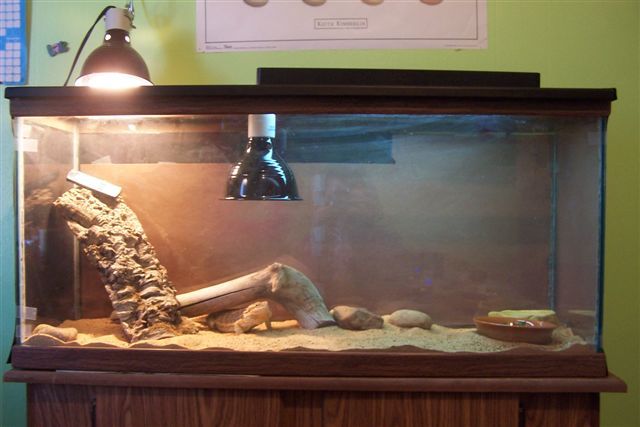 her room
her room
QUESTION: Thank you so much for the help. I feel I need to say that my breeder has helped me alot, but I just don't feel I am getting what I needed from him. I do have to say the room she is in is very active, it is my daughters bedroom and it happens to be one of our 4 cats favorite room. We are also handling her through out the day. should that stop?? We have 3 of the sides of her room covered, should we cover the front? I am using a Fluker digital, I do plan on getting a better system. I have included a picture, but all the lights are on the inside, but the ceramic heater. in the picture the heat light is on the outside, I switched the 2 lights, it's inside now and the ceramic is on the outside. Also the last stool she had was very firm. Are you concerned that she might have cocidia?? I know there can be a explosion of the good bacteria in the intestines, but to much can cause problems, and not let the body absorb the food.
Do you suggest force feeding?? and if so HOW?
ANSWER: Hi Renee,
Sorry for the late reply but we had bad storms (rain) and my DSL went down..its still down and my dialup is painfully slow...hopefully this even gets through.
First...I would remove the sand as you saw in my caresheet sand is not recommended for baby beardies and in many cases not even adults.
In looking at the picture, where she would lay to get heat, there is no uvb or is at a distance far greater than 6-8 inches.
She may be stressing from all the activity in the room and with cats, they are nocturnal so they may be upsetting her sleep patterns which adds even more stress.
I'm not a big fan of any heat sources on the inside of a cage because they can and will at some point try to get onto the fixture.
Its possible she can have coccidia or other parasites as stress causes the higher load of them. If the breeder did medicate them, their load may have been low at the time, but stress increases the load and decreases the needed bacteria. Using a gut flora booster as directed for a treatment and once a week or once every two weeks keeps the bacteria at a level that is good. We don't know what reptiles really do in the wild to keep their gut processes working properly so we do what we know to help.
Before going to force feeding (which I don't recommend actual FORCE feeding unless instructed to do so by a vet) I would try to lessen the activity in her room, especially at night. Until her activity levels are controlled at night she will most likely remain very stressed during the day, wanting to sleep and hide. They really do need that 10-14 hrs(depending on season) of uninterrupted sleep. I would hold her less during the day, but not stop completely.
Beardies are very social and covering all her exposed areas may stress her even more. It would be better to work on controlling the activity even if it means moving her to another room or adding a screen door to your daughters room to keep the cats out, especially at night. In time she will get used to the daytime ventures of the cats. Another thing at night, if your daughter has the computer on, or lights, then she will need to find a way to block the lights from her or give her a nice dark hide..or both.
---------- FOLLOW-UP ----------
QUESTION: Diane, 1 more day gone by without so much as a look at the food. How long can she go one this way. I am getting so worried the worst will happen. We have closed off my daughter room to every thing but the gold fish. Her room is quite with just use going in checking on her a few times a day. The only light that is on in the room at night is from her clock. I have her lights coming on at 6 am and going off at 9 pm. should I change that??
Thank you for every thing
AnswerHi Renee,
The easiest way to set her lights is with sunrise and sunset... or to use the 12 on /12 off schedule.
The clock light should not bother her.
Have you tried using bene bac or other product? A 3 day dosage is recommended. Some people have used soy yogurt(live culture) in a pinch for this. The amount given would be about 1/4 CC a day for 3 days..although the manufactured products are more recommended.
If she is drinking, they can go quite awhile without eating, but of course that's not good for them to do.
The only other option is a vet which may give her a Vitamin B shot which works on some reptiles.
Try offering her some baby food chicken from an eye dropper or syringe, no needle. She may lick at it when placed on her mouth. Her is a bit more info on this: http://www.reptilerooms.com/Sections+index-req-viewarticle-artid-42-page-1.html


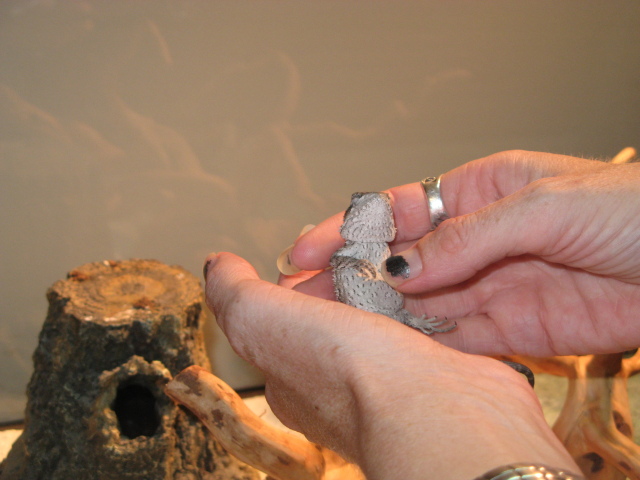 Beardie & Greens?
QuestionBearded Dragon (Puff)
QUESTION: How do I
Beardie & Greens?
QuestionBearded Dragon (Puff)
QUESTION: How do I
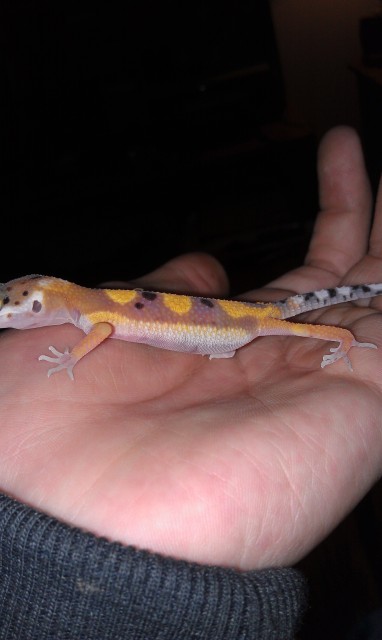 Vomiting Leopard Gecko
QuestionBloating and Tail
QUESTION: Hi Tracie,
T
Vomiting Leopard Gecko
QuestionBloating and Tail
QUESTION: Hi Tracie,
T
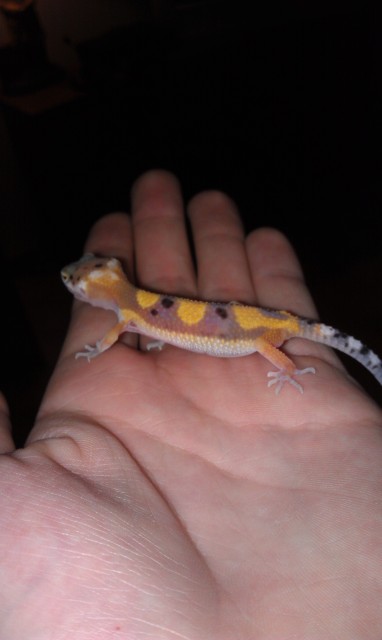 Vomiting Gecko
QuestionQUESTION: Hey Tracie,
Its Sean sorry I couldnt
Vomiting Gecko
QuestionQUESTION: Hey Tracie,
Its Sean sorry I couldnt
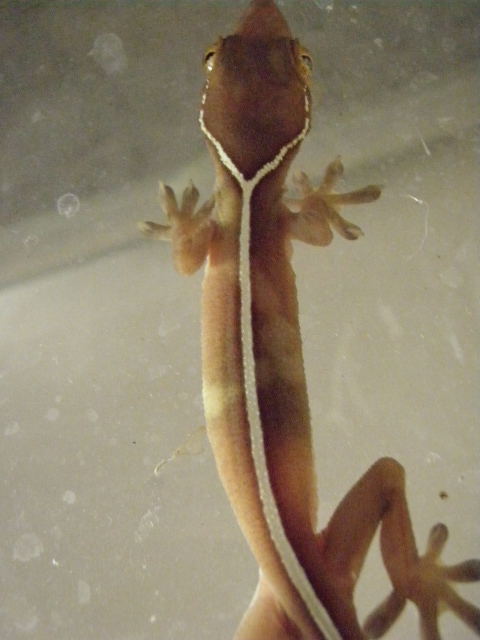 spots on gekko vittatus
Question
Spots foto
Hello, I have recently notic
spots on gekko vittatus
Question
Spots foto
Hello, I have recently notic
 Bearded Dragon - Eye issue
QuestionStella 1
QUESTION: Hey,
I have a bearded
Bearded Dragon - Eye issue
QuestionStella 1
QUESTION: Hey,
I have a bearded